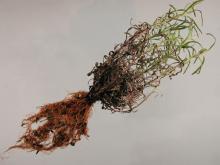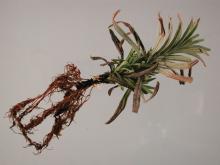Cause The OSU Plant Clinic has found Fusarium, Phytophthora, Pythium and Rhizoctonia associated with rotting roots of lavender. These pathogens, including Fusarium avenaceum, P. megasperma from field grown plants and P. nicotianae from nursery stock, have also been found in Washington. In the eastern USA, many different Phytophthora species have been found: Phytophthora nicotianae, P. palmivora, and P. cinnamomi on hybrid lavender (Lavandula x intermedia), P. nicotianae on sweet lavender (L. heterophylla), and P. citrophthora, P. cryptogea, P. drechsleri, P. nicotianae and P. palmivora on English lavender (L. angustifolia). They are typically found in cold wet soils where lavender does not do well. Overwatering is another problem that encourages these diseases.
Symptoms Roots develop a discolored vascular system, turn black and rot. Aboveground plant parts wilt and dieback. Foliage may be off color at first before it collapses. In general, root rots due to Pythium do not move up into the stem area like Phytophthora does.
Cultural control
- Plant lavender in sunny locations with well-drained soils.
- Shading may be necessary to manage Phytophthora when growing plants in black plastic pots.
- Do not incorporate high levels of organic matter that retain moisture around plants.
- Do not overwater.
- Does best at a pH of 5.8 to 7.0.
- Keep plants off the ground for nursery production.
Chemical control The following materials may be helpful before symptoms develop especially if Pythium or Phytophthora are involved. Focus on cultural controls first.
- Adorn at 1 to 4 fl oz/100 gal water plus another fungicide. Group 43 fungicide. 12-hr reentry.
- Fosphite at 1 to 3 quarts/A. Do not use copper products within 20 days of treatment and do not use spray adjuvants. Group P7 fungicide. 4-hr reentry.
- Monterey Garden Phos at 0.25 teaspoons/1 pint water/100 sq ft as a foliar spray. Group P7 fungicide. H
- Reliant at 2 qt/A as a foliar spray. Group P7 fungicide.
- Segway SC at 1.5 to 3 fl oz/100 gal water. Drench rate is based on pot diameter. Group 21 fungicide. 12-hr reentry.
- Subdue MAXX at 1 oz/100 gal water as a drench. Group 4 fungicide. No restrictions on reentry when used as a soil drench.
- Warhammer (chitosan) at 4 to 12 fl oz/A on 7- to 14-day intervals. Studies at the University of Florida showed a reduction in disease severity for Phytophthora blight in squash when chitosan was applied as a 1% soil drench. No preharvest interval or reentry interval requirement.
Biological control
- RootShield Plus Granules (Trichoderma harzianum Rifai strain T-22 and T. virens strain G-41) at 1 to 3 lb/ cubic yard soil mix. No restrictions on reentry when soil incorporated. O
Reference Dlugos, D. M., Bridges, W. C. and Jeffers, S. N. 2024. Phytophthora Root and Crown Rot of Lavender: New Host-Pathogen Relationships Involving Six Species of Phytophthora and Three Species of Lavandula. Plant Disease, 108:769-777.
Guarnaccia, V., Hand, F. P., Garibaldi, A. and Gullino, M. L. 2021. Bedding plant production and the challenge of fungal diseases. Plant Disease, 105:1241-1258.
Mo, X., and Zhang, S. 2013. Effect of chitosan, Heads Up and TiO2 on Phytophthora blight in squash, 2012. Plant Disease Management Reports 7:V081.



